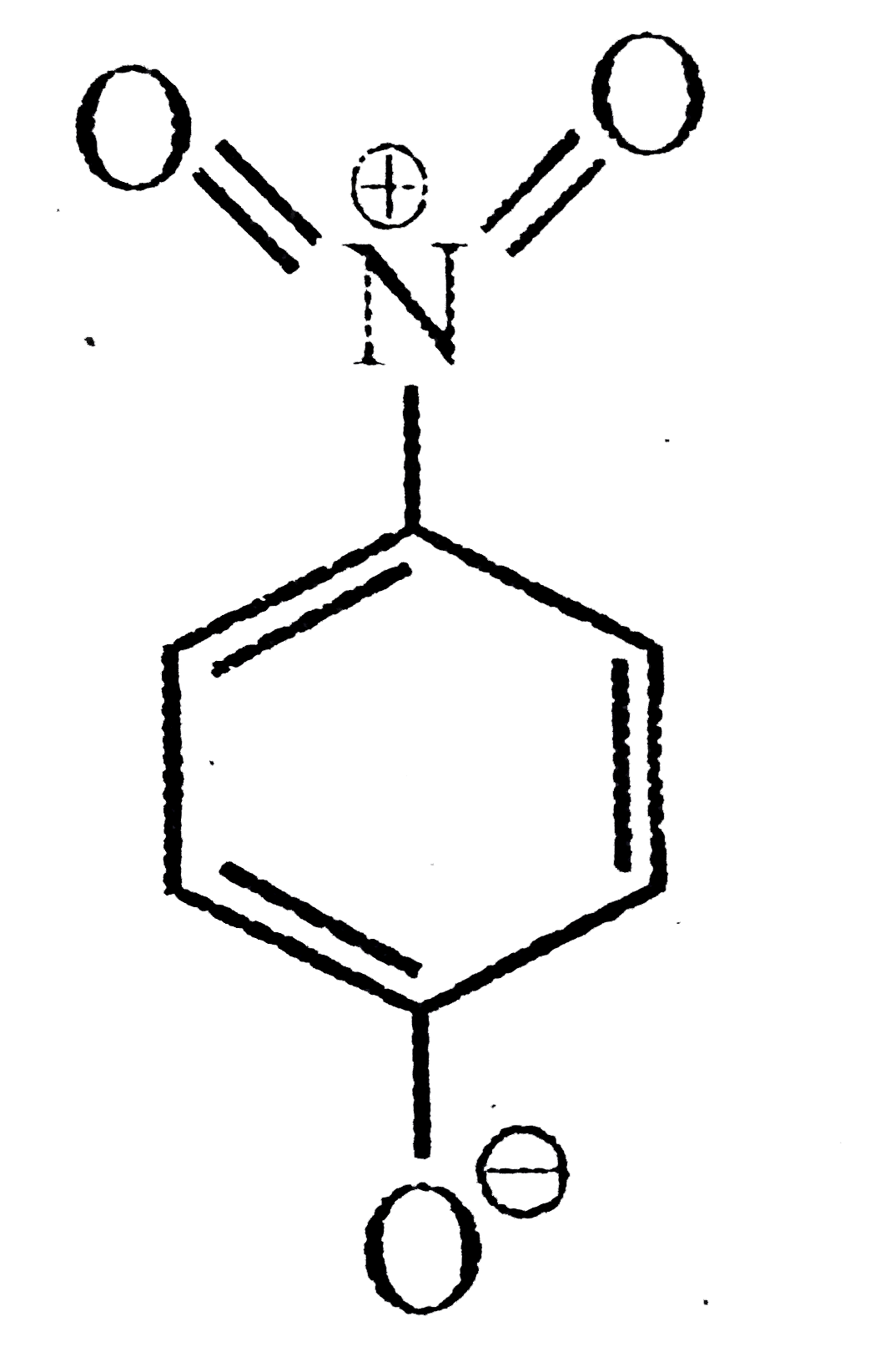The most unlikely representation of resonance structures of p-nitrophenoxide ion is:




The correct Answer is:C
To determine the most unlikely representation of resonance structures for the p-nitrophenoxide ion, we need to analyze the possible resonance structures that can be drawn for this ion. Here’s a step-by-step solution:
Step 1: Understand the Structure of p-Nitrophenoxide Ion
The p-nitrophenoxide ion is derived from phenol by the substitution of a nitro group (-NO2) at the para position and the deprotonation of the hydroxyl group (-OH) to form the phenoxide ion. The structure can be represented as follows:
- A benzene ring with a -NO2 group at the para position and a negatively charged oxygen atom.
Step 2: Draw Possible Resonance Structures
Resonance structures are different ways of drawing the same molecule that show the delocalization of electrons. For the p-nitrophenoxide ion, we can draw several resonance structures:
1. Structure 1: The negative charge on the oxygen atom, with the nitro group maintaining its structure.
2. Structure 2: The negative charge can be delocalized to the ortho position of the benzene ring.
3. Structure 3: The nitro group can also participate in resonance, where the oxygen of the nitro group can have a positive charge, and the negative charge can be on the benzene ring.
4. Structure 4: A structure where the nitro group has a positive charge and the negative charge is on the adjacent carbon of the benzene ring.
Step 3: Identify the Most Unlikely Resonance Structure
Among the structures drawn, the most unlikely resonance structure would be one that violates the octet rule or has an unfavorable charge distribution. For example, if we draw a structure where both the nitro group and the oxygen have positive charges, this would be highly unfavorable due to the repulsion between like charges and the violation of the octet rule.
Conclusion
The most unlikely representation of resonance structures for the p-nitrophenoxide ion is the one where both the nitro group and the oxygen atom carry a positive charge.
---
The p-nitrophenoxide ion is derived from phenol by the substitution of a nitro group (-NO2) at the para position and the deprotonation of the hydroxyl group (-OH) to form the phenoxide ion. The structure can be represented as follows:
- A benzene ring with a -NO2 group at the para position and a negatively charged oxygen atom.
Resonance structures are different ways of drawing the same molecule that show the delocalization of electrons. For the p-nitrophenoxide ion, we can draw several resonance structures:
1. Structure 1: The negative charge on the oxygen atom, with the nitro group maintaining its structure.
2. Structure 2: The negative charge can be delocalized to the ortho position of the benzene ring.
3. Structure 3: The nitro group can also participate in resonance, where the oxygen of the nitro group can have a positive charge, and the negative charge can be on the benzene ring.
4. Structure 4: A structure where the nitro group has a positive charge and the negative charge is on the adjacent carbon of the benzene ring.
Among the structures drawn, the most unlikely resonance structure would be one that violates the octet rule or has an unfavorable charge distribution. For example, if we draw a structure where both the nitro group and the oxygen have positive charges, this would be highly unfavorable due to the repulsion between like charges and the violation of the octet rule.
The most unlikely representation of resonance structures for the p-nitrophenoxide ion is the one where both the nitro group and the oxygen atom carry a positive charge.
Topper's Solved these Questions
- ORGANIC COMPOUNDS CONTAINING NITROGENBOOK - A2ZCHAPTER - ORGANIC COMPOUNDS CONTAINING NITROGENEXERCISE - Section B - Assertion Reasoning
11 Videos
- ORGANIC COMPOUNDS CONTAINING NITROGENBOOK - A2ZCHAPTER - ORGANIC COMPOUNDS CONTAINING NITROGENEXERCISE - AIPMT/NEET Questions
26 Videos
- ORGANIC COMPOUNDS CONTAINING NITROGENBOOK - A2ZCHAPTER - ORGANIC COMPOUNDS CONTAINING NITROGENEXERCISE - Aromatic Amines And Diazonium Salts
61 Videos
- ORGANIC COMPOUNDS CONTAINING HALOGENSBOOK - A2ZCHAPTER - ORGANIC COMPOUNDS CONTAINING HALOGENSEXERCISE - Section D - Chapter End Test
30 Videos
- P BLOCK ELEMENTS ( GROUP 15,16,17,18)BOOK - A2ZCHAPTER - P BLOCK ELEMENTS ( GROUP 15,16,17,18)EXERCISE - Section D - Chapter End Test
30 Videos
Similar Questions
Knowledge Check
The most unlikely representation of resonance structure of p-nitrophenoxide ion is:
A B
B C
C D
D
The most unlikely representation of resonance structure of p-nitrophenoxide ion is:
A B
B C
C D
D
The most unlikely representation of resonance structure of p-nitrophenoxide ion is :-
A B
B C
C D
D
The most unlikely representation of resonance structure of p-nitrophenoxide is :
View SolutionThe most unlikely representation of resonance structuresof nitrophenoxide ion is
View SolutionThe most likely representation of resonance structure of p-nitrophenoxide is :
View SolutionThe most unlikely resonating structures of pnitrophenoxide ion is :
View SolutionThe pair represention valid resonating structure is
View Solution
